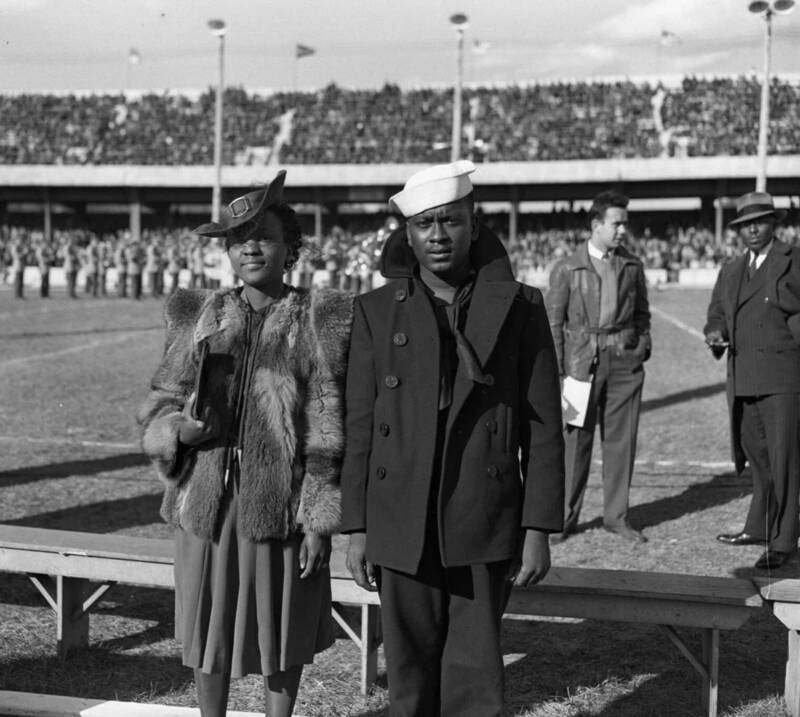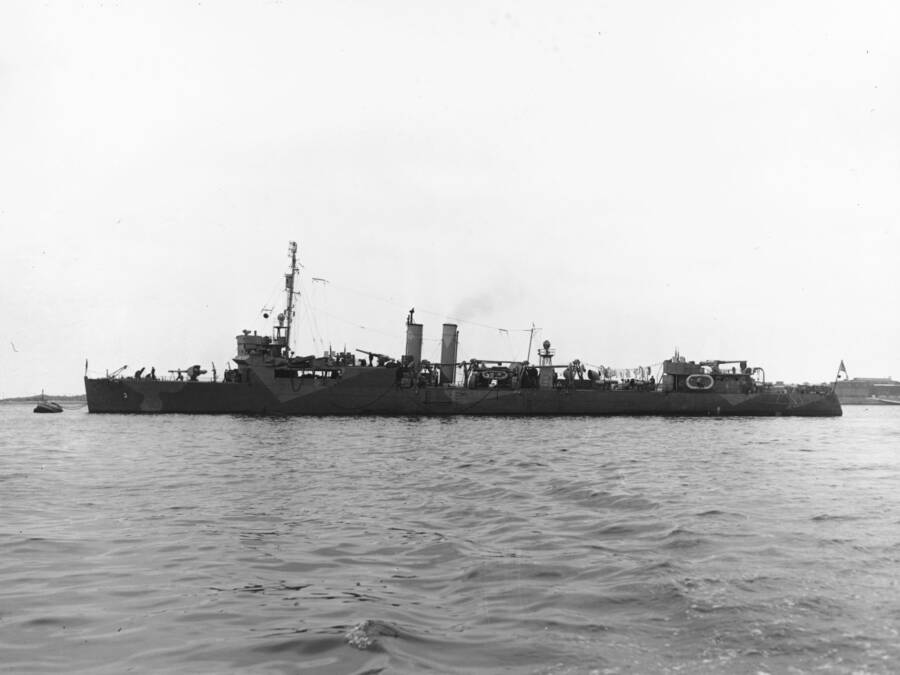When the USS Gregory sank in 1942, a mess hall officer named Charles Jackson French dragged a raft full of his wounded crewmates to safety through shark-infested waters.

TwitterCharles Jackson French was posthumously awarded the Navy and Marine Corps Medal for his bravery.
On a pitch-black night in 1942, the waters of the Pacific Ocean near Savo Island and Guadalcanal suddenly lit up with gunfire. Within minutes, two American ships on patrol were sunk by Japanese destroyers. And as sharks circled below, and Japanese soldiers fired from all around, a Black mess officer named Charles Jackson French leaped into action.
French, one of the only uninjured sailors, discarded his waterlogged clothing, tied a rope around his waist, and started to swim. For six to eight hours, he tugged a raft filled with injured sailors behind him, pulling them to safety.
But, while his heroic story was later made public, Charles Jackson French received little recognition during his life. Instead of a medal, he was sent a letter of “commendation.”
It wasn’t until recent years — and long after his death at the age of 37 — that this hero finally received his due.
‘I Want To Do My Part’
Born on Sept. 29, 1919, Charles Jackson French spent his early years in Foreman, Arkansas. At the time, Black and white pools were segregated, making it difficult for Black people to find opportunities to learn to swim. Swimming World Magazine speculates that French may have learned to swim by visiting the city’s stone quarries and the Red River.
However he learned to swim, French’s days in Foreman were numbered. After his parents died, he left Arkansas and moved in with his married, older sister Viola in Omaha, Nebraska. And by the time he was 18, French decided to strike out on his own and enlist in the U.S. Navy
The Navy, like swimming pools across the country, was strictly segregated. As a Black man, French had virtually no other choice than to work as a mess attendant. In that capacity, the U.S. Navy Office Of Information reports that French spent four years the USS Houston, serving meals to the white sailors, cleaning their tables, and keeping the mess hall spick and span.
French returned to Omaha when his deployment ended in November 1941, but he wouldn’t stay in Nebraska for long. After the Japanese attack on Pearl Harbor on Dec. 7, 1941, French promptly re-enlisted.
“I want to do my part, because I’m already trained and I can start right away,” French said at the time.
He had spent his last tour cruising around the Pacific. But this time, Charles Jackson French would see significantly more action.
Charles Jackson French’s Heroism During World War II

Public DomainCharles Jackson French was assigned to the USS Gregory, which was destroyed in September 1942.
Following his re-enlistment, Charles Jackson French was assigned to the USS Gregory as a Steward’s Mate 1st class. According to Swimming World Magazine, French’s rank was elevated above a mere mess mate, but he and others were still derided in the Black press as “seagoing bellhops.”
After six months at sea, however, French would prove that he was much more than a bellhop — seagoing or otherwise.
Then, on Sept. 5, 1942, the USS Gregory and the USS Little were attacked by Japanese destroyers around 1 a.m. while patrolling the waters near Savo Island and Guadalcanal. The U.S. Navy Office Of Information reports that the Gregory, outgunned, sank after just three minutes. Its surviving men were plunged into shark-infested waters as the Japanese fired on them.
But French leaped into action. The 23-year-old helped injured sailors onto a makeshift raft and — when U.S. Navy Ensign Robert Adrian told him that the current would pull the raft toward a Japanese-occupied island — volunteered to jump in the water and pull the raft in the other direction.
Adrian told him it was impossible. French, according to Adrian, replied: “Just keep telling me if I’m goin’ the right way.”
He shed his waterlogged clothes, tied a rope around his waist, and started to swim. For the next six to eight hours, French tirelessly swam as sharks got so close that they sometimes brushed against his legs. At sunrise, an American scout finally spotted him and the others and sent rescue.

War Gum Trading Card CompanyA depiction of Charles Jackson French’s heroism from the
But French’s ordeal didn’t end there. As he later recounted, as recorded by Chester Wright in Black Men and Blue Water, French and other uninjured soldiers were taken to a rest camp by their rescuers, who wanted to separate French from the white sailors. To French’s surprise, the sailors insisted that French stay with them as a fellow member of Gregory’s crew.
“Them white boys stood up for me,” French emotionally told Wright.
The story of Charles Jackson French’s heroism was later made public by Adrian, who described it on a radio program called It Happened in the Service in October 1942, according to Swimming World Magazine. Adrian had never learned French’s full name — he and the others only knew him as “French” — but he fully credited him for their rescue that day.
“I can assure you that all the men on that raft are grateful to mess attendant French for his brave action off Guadacanal that night,” Adrian said.
The story was soon picked up by the national news, and Charles Jackson French was identified by NBC. He was celebrated across the country, featured in a comic strip, and lauded by the Black press.
Adrian “and other white Americans owe their LIVES to a black man whom he identified as a ‘mess attendant named French,'” the Pittsburgh Courier, a Black newspaper, wrote after French was identified.
The newspaper continued: “Although Mess Attendant Charles Jackson French of Arkansas was not in a heroic job, he MADE a heroic job out of it. He who had been looked down upon as a caste man, frozen in status, suddenly was looked up to as a SAVIOUR.”
Though rumors spread that Charles Jackson French might be awarded the Navy Cross, he was given only a letter of commendation from Admiral William F. Halsey, Jr., the then-commander of the Southern Pacific Fleet.
French may have been denied the medal because a Silver Star was awarded to one of his superiors — and it was unprecedented to award a higher medal to a subordinate. But the Omaha World-Herald noted some decades later that future president John F. Kennedy had been given the Navy and Marine Corps Medal for a similar act of bravery.
Charles Jackson French, on the other hand, was slowly forgotten.
The Legacy Of Charles Jackson French

U.S. NavyCharles Jackson French salutes while next to his sister Viola at a Creighton University football game on Oct. 31, 1942.
After his service on the USS Gregory, Charles Jackson French didn’t rest on his laurels. He returned to his role in the mess on the USS Endicott and the USS Frankford, and witnessed D-Day and the invasion of southern France.
After World War II ended, French faded from the public eye. Black Past reports that he suffered from alcoholism and depression, and passed away on Nov. 7, 1956, in San Diego, California. He was only 37 years old.
But since then, there’s been a push to give this forgotten World War II hero his due. In April 2021, a post about French from the International Swimming Hall of Fame revived his story. And a year later, Rear Admiral Charles Brown, the Navy public affairs officer, presented eight of French’s relatives with a posthumous Navy and Marine Corps Medal — just like Kennedy’s.
“It will inspire generations of sailors,” Brown said at the medal ceremony, reported by the Omaha World-Herald. “It’s a story of the best of who we are.”
French has been honored in other ways, too. A training pool at Naval Base San Diego was named after French, and a post office in his hometown of Omaha also bears his name.
In life, French wasn’t honored like he deserved. Wright notes that his death didn’t merit even “two paragraphs” in the San Diego press when he died. But finally, after six decades, his heroic acts during World War II are finally being recognized and rewarded.
“I’ve always felt glad to be a proud American,” his nephew, Roscoe Harris, told the Omaha World-Herald, after attending his uncle’s medal ceremony. The 89-year-old added: “I was happy to see that, as an American Black man, (French) got recognized.”
After reading about Charles Jackson French, discover the story of Doris Miller, a Black ship’s cook who became a naval hero during the attack on Pearl Harbor. Or, discover the forgotten stories of some of America’s most impressive Black war heroes.





